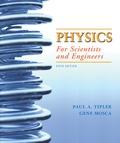
Concept explainers
(a)
Toshow: The ratio of the force exerted on a point particle on the surface of Earth by the Sun to that exerted by the moon is,
(a)
Explanation of Solution
Given information :
Mass of the Sun
Mass of the Moon
Distance of the particle from Earth to Sun
Distance of the particle from Earth to Moon
Mass of the Sun
Mass of the Moon
Average orbital distance between earth and sun
Average orbital distance between earth and moon
Formula used :
Gravitational force between two masses ( M and m ) separated by distance r is:
G is the gravitational constant.
Proof:
Express the force exerted by the sun on a body of water of mass,
Express the force exerted by the moon on a body of water of mass
Divide equation (1) by (2)
Substitute the values and solve:
(b)
ToShow:
(b)
Explanation of Solution
Given information :
Mass of the Sun
Mass of the Moon
Distance of the particle from Earth to Sun
Distance of the particle from Earth to Moon
Formula used :
Gravitational force between two masses ( M and m ) separated by distance r is:
G is the gravitational constant.
Calculation:
Differentiate the expression with respect to r :
Re-arrange the expression:
(c)
To Show:For a small difference in distance compared to the average distance, the ratio of the differential gravitational force exerted by the Sun to the differential gravitational force exerted by the moon on Earth’s oceans is given by
(c)
Explanation of Solution
Given information :
Mass of the Sun
Mass of the Moon
Distance of the particle from Earth to Sun
Distance of the particle from Earth to Moon
Formula used :
From part b,
Calculations:
The change in force
Because the difference in the distance is small,
Substitute the numerical values
Want to see more full solutions like this?
Chapter 11 Solutions
Physics for Scientists and Engineers
- A capacitor with a capacitance of C = 5.95×10−5 F is charged by connecting it to a 12.5 −V battery. The capacitor is then disconnected from the battery and connected across an inductor with an inductance of L = 1.55 H . At the time 2.35×10−2 s after the connection to the inductor is made, what is the current in the inductor? At that time, how much electrical energy is stored in the inductor?arrow_forwardCan someone help me with this question. Thanks.arrow_forwardCan someone help me with this question. Thanks.arrow_forward
 Principles of Physics: A Calculus-Based TextPhysicsISBN:9781133104261Author:Raymond A. Serway, John W. JewettPublisher:Cengage Learning
Principles of Physics: A Calculus-Based TextPhysicsISBN:9781133104261Author:Raymond A. Serway, John W. JewettPublisher:Cengage Learning University Physics Volume 1PhysicsISBN:9781938168277Author:William Moebs, Samuel J. Ling, Jeff SannyPublisher:OpenStax - Rice University
University Physics Volume 1PhysicsISBN:9781938168277Author:William Moebs, Samuel J. Ling, Jeff SannyPublisher:OpenStax - Rice University Classical Dynamics of Particles and SystemsPhysicsISBN:9780534408961Author:Stephen T. Thornton, Jerry B. MarionPublisher:Cengage Learning
Classical Dynamics of Particles and SystemsPhysicsISBN:9780534408961Author:Stephen T. Thornton, Jerry B. MarionPublisher:Cengage Learning Glencoe Physics: Principles and Problems, Student...PhysicsISBN:9780078807213Author:Paul W. ZitzewitzPublisher:Glencoe/McGraw-Hill
Glencoe Physics: Principles and Problems, Student...PhysicsISBN:9780078807213Author:Paul W. ZitzewitzPublisher:Glencoe/McGraw-Hill Physics for Scientists and Engineers: Foundations...PhysicsISBN:9781133939146Author:Katz, Debora M.Publisher:Cengage Learning
Physics for Scientists and Engineers: Foundations...PhysicsISBN:9781133939146Author:Katz, Debora M.Publisher:Cengage Learning An Introduction to Physical SciencePhysicsISBN:9781305079137Author:James Shipman, Jerry D. Wilson, Charles A. Higgins, Omar TorresPublisher:Cengage Learning
An Introduction to Physical SciencePhysicsISBN:9781305079137Author:James Shipman, Jerry D. Wilson, Charles A. Higgins, Omar TorresPublisher:Cengage Learning





